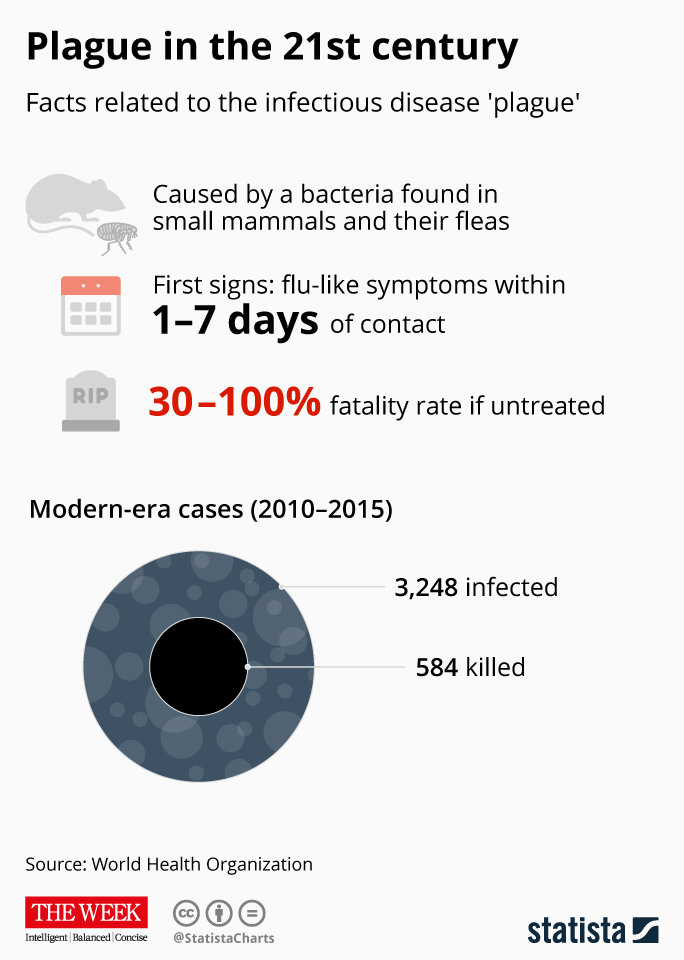Madagascar plague: Middle Ages’ disease now a modern killer
Nine other African countries on high alert after more than 200 deaths in island nation

A sudden and rapid outbreak of plague in the past few months has led to more than 200 deaths and at least 2,348 suspected and confirmed cases on the Indian Ocean island of Madagascar.
Although the outbreak in Madagascar, off Africa’s southeastern coast, appears to be slowing down, its severity and speed has raised fears about the likelihood of the disease claiming more lives. Nine other countries and overseas territories in the African region remain on high alert, the World Health Organization reports.
Across the globe, plague “flare-ups cause public health emergencies on an almost annual basis”, according to Vox. The Democratic Republic of Congo, Peru and India regularly report cases, and the disease has also been seen in the US, in dry southwestern states including Arizona, California, New Mexico and Colorado. The US Center for Disease Control and Prevention (CDC) says there were 16 plague cases reported nationwide, resulting in four deaths, in 2015.
The Week
Escape your echo chamber. Get the facts behind the news, plus analysis from multiple perspectives.

Sign up for The Week's Free Newsletters
From our morning news briefing to a weekly Good News Newsletter, get the best of The Week delivered directly to your inbox.
From our morning news briefing to a weekly Good News Newsletter, get the best of The Week delivered directly to your inbox.
“You get rodent populations that still carry the disease,” Don Walker, a bone specialist at the Museum of London Archaeology who studies the DNA of skeletons of Black Death victims, told Al Jazeera. “And occasionally, there might be someone out there who gets too close and can get infected.”
But how much of a threat does plague really pose to the modern world and who is most at risk?
The history of plague
Plague is caused by a bacterium known as Yersinia pestis, and is life threatening if not treated quickly, says the Harvard Health Publishing website. The disease primarily affects rodents such as rats, mice, squirrels, prairie dogs, chipmunks and rabbits. The CDC says it is most commonly transmitted to humans when they are bitten by a flea infected with plague bacteria.
A free daily email with the biggest news stories of the day – and the best features from TheWeek.com
There are three forms of plague. Bubonic is the most common, accounting for more than 80% of all reported cases in the US. Painful, dark swellings known as buboes usually appear near the site of an infected bite, followed by a fever, chills, muscle aches, headache and extreme weakness. Without proper treatment, the carrier may develop septicemic plague.
Septicemic plague, the second-most common form of the disease, is the infection of a carrier’s blood. Symptoms can include nausea, vomiting, diarrhea and abdominal pain, along with internal bleeding. However, with appropriate treatment, 75% to 80% of sufferers survive, the Harvard website says.
Pneumonic plague is the deadliest form, developing when Yersinia pestis infects the lungs. Without proper treatment, pneumonic plague can quickly lead to death.
Although Yersinia pestis was not officially documented as the cause of plague until 1894, it is believed to have caused devastating pandemics dating back as far as AD541, the CDC says. The most significant outbreak was the Black Death in the mid-14th century, which is estimated to have killed between 75 million and 200 million people - including 30% to 60% of Europe’s entire population - in just a few years.
Current risk
Plague has become a relatively rare disease, as all forms can be treated with antibiotics, but there are still thousands of cases each year.
Countries in Africa, South America and Asia regularly suffer minor outbreaks, with Madagascar, the Democratic Republic of Congo, Peru and India most frequently hit.
The Democratic Republic of Congo alone recorded more than 10,000 cases between 2000 and 2009, according to a study by the American Journal of Tropical Medicine and Hygiene. In the same period, 57 cases of plague were reported in the US, with seven deaths.
Most of the US cases were believed to have originated in rock squirrels and ground squirrels, two species in which plague has become endemic in America.

Why can’t we beat a medieval disease?
“The tragedy in most cases is that people don’t realise what they have and think they have the flu,” Sharon Collinge, professor of environmental studies at the University of Colorado Boulder, told CNN.
Financial considerations may also stop many people from seeking treatment.
“For some people, it costs money to seek healthcare and if you don’t believe that you have a severe disease, maybe you’ll say, “Why am I gonna spend money to go seek healthcare when I’m sure I’ll get better soon”, and just wait it out,” virologist Daniel Bausch told NPR. “Because in the beginning, the plague doesn’t seem that different from a cold or other respiratory disease.”
“And there still can be a stigma - people don’t want to be recognized as having the disease,” Bausch adds.
Ultimately, Collinge concludes, plague is “like a lot of pathogens”, insofar as “it’s persistent and emerges at certain times and places for reasons that still remain somewhat mysterious”.
Infographic by www.statista.com/chartoftheday for TheWeek.co.uk
-
 The small Caribbean island courting crypto billions
The small Caribbean island courting crypto billionsUnder the Radar Crypto mogul Olivier Janssens plans to create a libertarian utopia on Nevis
-
 Political cartoons for December 21
Political cartoons for December 21Cartoons Sunday’s political cartoons include Christmas movies, AI sermons, and more
-
 A luxury walking tour in Western Australia
A luxury walking tour in Western AustraliaThe Week Recommends Walk through an ‘ancient forest’ and listen to the ‘gentle hushing’ of the upper canopy
-
 How Bulgaria’s government fell amid mass protests
How Bulgaria’s government fell amid mass protestsThe Explainer The country’s prime minister resigned as part of the fallout
-
 Femicide: Italy’s newest crime
Femicide: Italy’s newest crimeThe Explainer Landmark law to criminalise murder of a woman as an ‘act of hatred’ or ‘subjugation’ but critics say Italy is still deeply patriarchal
-
 Brazil’s Bolsonaro behind bars after appeals run out
Brazil’s Bolsonaro behind bars after appeals run outSpeed Read He will serve 27 years in prison
-
 Americans traveling abroad face renewed criticism in the Trump era
Americans traveling abroad face renewed criticism in the Trump eraThe Explainer Some of Trump’s behavior has Americans being questioned
-
 Nigeria confused by Trump invasion threat
Nigeria confused by Trump invasion threatSpeed Read Trump has claimed the country is persecuting Christians
-
 Sanae Takaichi: Japan’s Iron Lady set to be the country’s first woman prime minister
Sanae Takaichi: Japan’s Iron Lady set to be the country’s first woman prime ministerIn the Spotlight Takaichi is a member of Japan’s conservative, nationalist Liberal Democratic Party
-
 Russia is ‘helping China’ prepare for an invasion of Taiwan
Russia is ‘helping China’ prepare for an invasion of TaiwanIn the Spotlight Russia is reportedly allowing China access to military training
-
 Interpol arrests hundreds in Africa-wide sextortion crackdown
Interpol arrests hundreds in Africa-wide sextortion crackdownIN THE SPOTLIGHT A series of stings disrupts major cybercrime operations as law enforcement estimates millions in losses from schemes designed to prey on lonely users